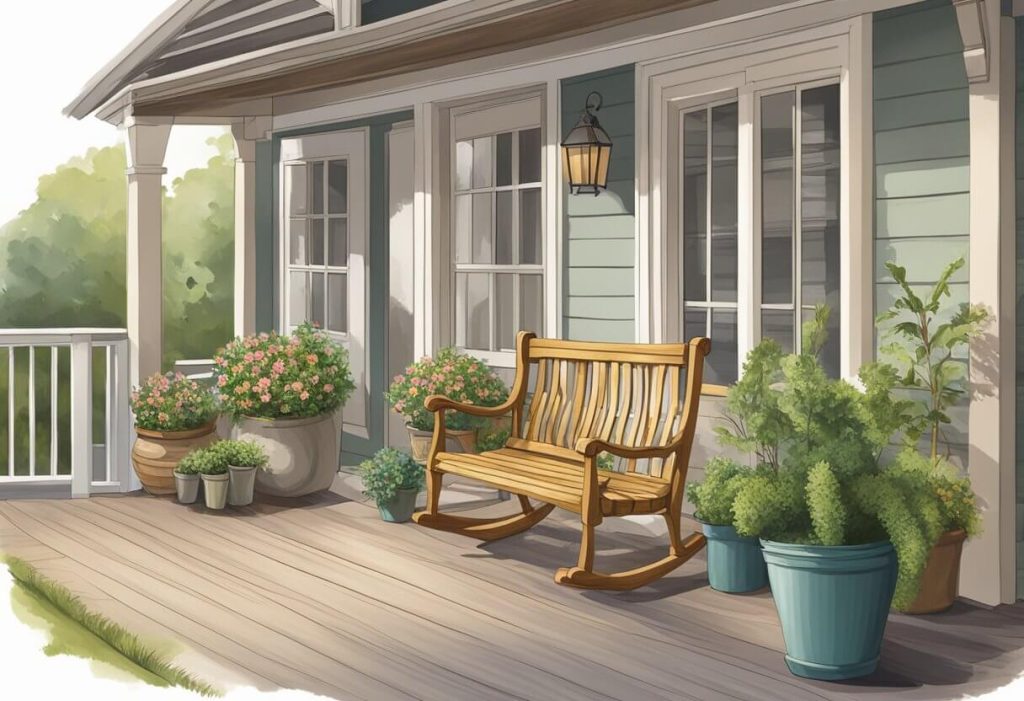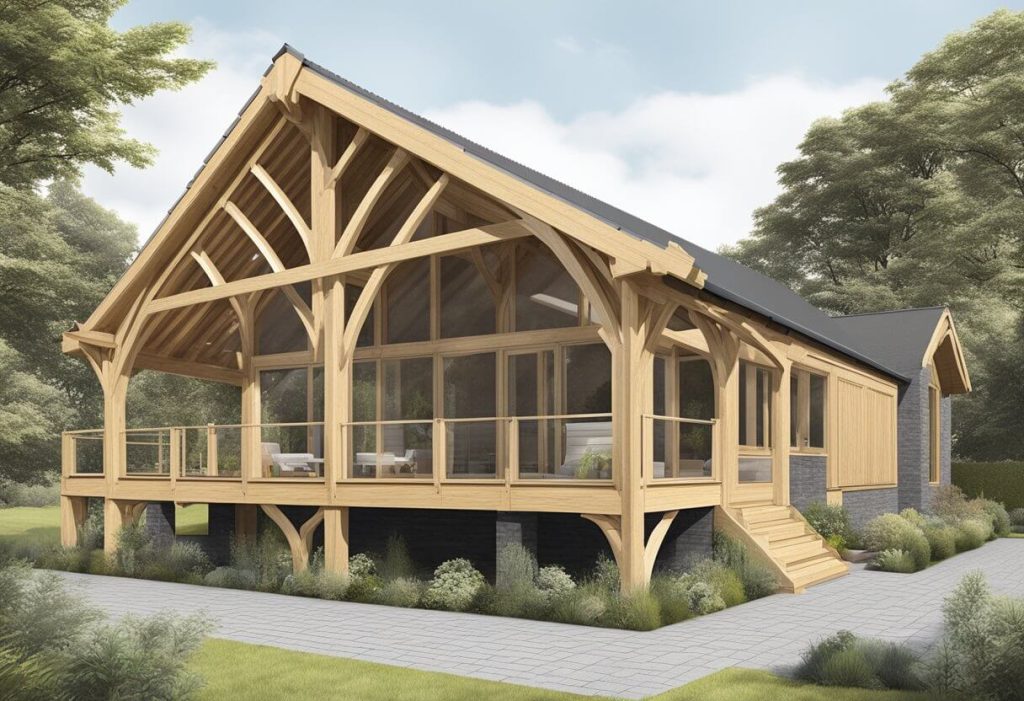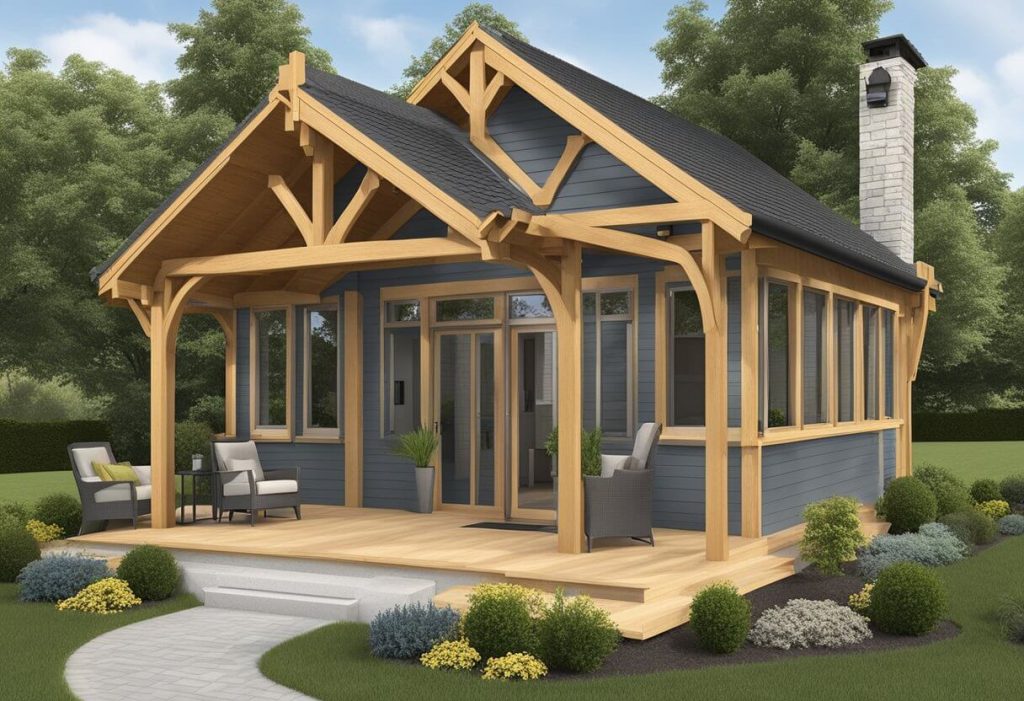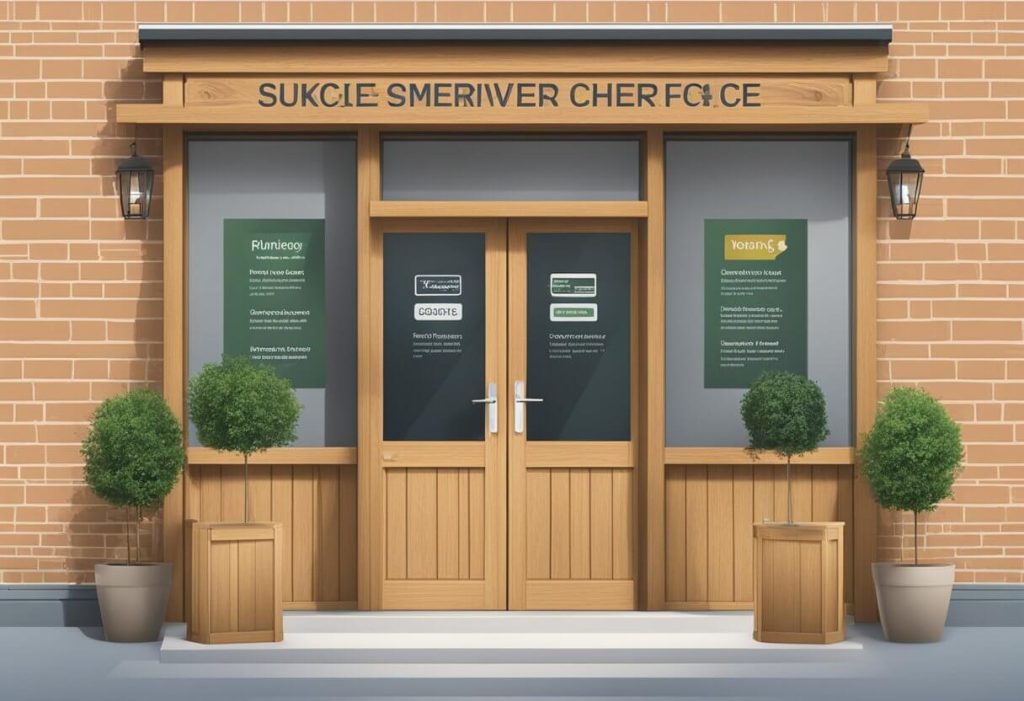Oak Frame Porch Design: Enhancing Your Home’s Entrance

Oak Frame Porch Design: Enhancing Your Home’s Entrance
The post Oak Frame Porch Design: Enhancing Your Home’s Entrance appeared first on UK Construction Blog.
Oak frame porches are a timeless addition to homes, providing not only a functional shelter but also enhancing the aesthetic appeal of the property. Built using traditional techniques, these structures invoke a sense of classic craftsmanship and durability. An oak porch serves as a natural extension of a home’s entrance, offering both practicality and kerb appeal.

With the option for bespoke designs, homeowners can tailor their oak porches to meet specific architectural and styling requirements. The natural qualities of oak ensure that each porch is unique, with the wood’s grain and character adding to the beauty of the construction. Oak is renowned for its strength and longevity, making it an ideal material for porch framing.
Key Takeaways
- Oak porches are structurally sound, adding both function and appeal to a home.
- Bespoke designs enable personalisation to align with individual tastes and house styles.
- Durability and natural beauty are inherent in oak, making it a quality choice for porch construction.
The Essence of Oak in Porch Construction
Oak is a distinguished material that has a rich heritage in construction, exemplifying strength and aesthetic appeal in porch design.
Historical Significance of Oak
Oak has a venerable history in the UK, serving as a traditional building material for centuries. Its use dates back to the time of early British settlers, where Quercus robur and Quercus petraea, two prominent native species of oak, became the backbone of architectural design. Oak’s resilience and availability made it the go-to choice for not just porches but also for constructing religious, residential, and agricultural structures.
Benefits of Oak Frame Porches
Oak frame porches bring a multitude of advantages—both functional and aesthetic. For one, green oak, or freshly cut oak, has inherent properties that allow it to harden and strengthen as it ages, thus ensuring durability. The visual impact of oak post and beam construction also adds a timeless ‘wow’ factor, effortlessly increasing a property’s kerb appeal. Oak is naturally resistant to fungal and insect infestations, reducing maintenance requirements. Additionally, oak’s insulating properties can contribute to energy efficiency in a home.
Oak Timber Varieties and Characteristics
Different oak species offer unique characteristics beneficial to porch construction:
- Quercus robur (English Oak): Known for its robust nature and longevity, English Oak is a popular choice for structural integrity and heritage projects.
- Quercus petraea (Sessile Oak): Favoured for its fine grain and resistance to water, making it suitable for exposed porch designs.
Both species, along with imported oaks, provide choices in colour, grain, and workability, allowing for bespoke porch designs that fulfil a plethora of architectural demands.
Designing Your Oak Frame Porch
When embarking on the design of an oak frame porch, it is essential to consider the visual appeal, functionality, and structural integrity. The design must integrate seamlessly with the existing property while also providing a warm and welcoming entrance.
Choosing the Right Design
Selecting the proper design for an oak frame porch hinges on the architectural style of the house and the homeowner’s preferences. Porch designs vary widely, from ornate to minimalistic. It’s prudent to sketch diverse design options, ranging from traditional to modern, ensuring the chosen porch design echoes the character of the home and meets the needs of its occupants.
Incorporating Traditional Joints and Aesthetics
The use of traditional joints in oak frame porches is not merely a nod to historic craftsmanship but also a choice that ensures longevity and strength. Commonly employed joints in oak framing include:
- Mortise and tenon
- Dowelled
These joints contribute to both the porch’s aesthetics and functionality. While designing the front truss, careful attention to the selection of joints can enhance the porch’s traditional appearance and structural stability.
Selecting the Ideal Oak Frame Type
The selection of the frame type is contingent on the desired aesthetic and design requirements of the property. Oak frame types include:
- Green oak
- Air-dried oak
Green oak is freshly sawn wood that retains moisture, making it easier to work with for intricate designs and allowing it to naturally season and harden in place. Air-dried oak has been left to dry for a lengthier period, reducing movement after construction. The choice of oak type will impact the porch’s appearance, durability, and maintenance level.
Planning and Permissions
Before embarking on the construction of an oak frame porch, it is essential to understand the intricacies of planning permission and to determine if your project is covered by permitted development rights. This will ensure compliance with local regulations and a smoother building process.
Understanding Planning Permission
Planning permission is a formal authorisation required in the UK to build new structures, make major changes to existing buildings, or to change the use of buildings or land. For an oak frame porch, the need for planning permission is typically determined by its size and scale.
Key points for planning permission include:
- Area: The external ground floor area must not exceed 3 square metres.
- Height: The porch must not be higher than 3 metres above ground level.
Here’s what must be present in the planning drawings if planning permission is required:
- Accurate scale, showing dimensions
- Details of materials and design
Navigating Permitted Development Rights
Permitted development rights allow certain building works and changes to be carried out without having to make a planning application.
Criteria under permitted development for oak frame porches:
- The porch should not extend beyond 3 metres in depth from the original house wall.
- The height should not surpass 3 metres to be within these rights.
Comprehending these rights will facilitate the process, potentially eliminating the need for a full planning application, provided your porch aligns with these parameters.
Kit Options and Assembly Details
Selecting the right oak porch kit involves understanding the various styles available and the assembly process involved. This section guides readers through different porch kit options and the steps required to assemble these kits.
Comparing Porch Kits: Full Height, Wall Mounted, and More
Oak porch kits are available in several configurations to suit different home aesthetics and structural requirements. Full height porch kits are standalone structures featuring traditional oak frames without the need for existing wall support. These offer a grand, classic look and make a strong architectural statement. Wall mounted porch kits, on the other hand, are designed to be affixed to the existing walls of a property, providing a seamless extension to the home’s façade. There are also variants like high brick plinth porch kits, which elevate the wooden structure on a brick base, ensuring stronger support and durability, while low brick plinth porch kits offer subtlety by incorporating a lower level of brickwork. Options like lean-to porch kits create a snug, covered area by leaning against an existing wall. For those with specific needs, bespoke oak framed porch kits can be crafted to any desired specification, seamlessly integrating with the individual character of a property.
Assembling Your Own Oak Porch Kit
Assembling an oak porch kit is designed to be straightforward, typically involving slot-together components that simplify the construction process. Most porch kits come with pre-cut joints, marked components for easier identification, and all necessary oak pegs for assembly. The key to successful easy assembly is following the manufacturer’s guide, which details how each piece fits together. Instruction manuals usually accompany the kit, providing step by step directives to ensure the process is as intuitive as possible. It is recommended that two individuals undertake the task, as some of the oak components can be heavy. Besides the inclusion of all timber elements, buyers may need to source additional materials such as fixings, bricks, or tiles from local builders’ merchants to complete the porch.
Construction Fundamentals
Constructing an oak frame porch involves precise ground preparation followed by the meticulous assembly of the wooden structure. These fundamental steps are crucial to ensure the porch’s stability and longevity.
Groundwork and Foundations
Before any construction can commence, it is imperative to lay a sturdy foundation. Foundations provide the necessary support to prevent structural movement and typically involve the excavation of the soil to a level that reaches the stable subsoil. The depth and specification of the foundations will depend on the soil type and the load of the structure. It is not uncommon to use staddle stones, which are stone or concrete supports that elevate the frame off the ground to protect it from moisture and insect damage.
- Excavate to stable subsoil
- Assess for a level base
- Install staddle stones if required
Assembling the Oak Frame Structure
Once the groundwork is completed, the assembly of the oak frame can begin. This process involves the careful erection of the structural components, ensuring each joint is secure and precise. The installation of the oak frame requires skilled craftsmanship, as the timber can be heavy and the connections complex. Each beam and post must be correctly aligned and pegged into place to create a framework that is both robust and aesthetically pleasing.
- Align and secure timber joints
- Peg beams and posts firmly
- Erect frame with precision
Through these essential steps, the construction of an oak frame porch can be successfully achieved, providing a timeless addition to any home.
Material Sourcing and Sustainability
The ethos of sustainability and the choice of high-quality materials are pivotal in the construction of an oak frame porch. The section below examines the considerations and practices in sourcing suitable timber and the commitment to eco-friendly methods.

Sourcing Quality Oak Timber
When selecting oak timber for framing, it is critical to ensure that the material is of the highest standard. Quality oak is often characterised by its strength, durability, and resistance to decay, which are attributes linked to the timber grading system. Builders must be vigilant in acquiring green oak that has been responsibly harvested and meets strict grading criteria, thus assuring both the integrity of the porch structure and adherence to sustainable values.
Sustainability and Eco-Friendly Practices
The construction industry’s burgeoning focus on sustainability has placed an emphasis on eco-friendly practices, particularly in the realm of traditional oak frame porches. Sustainability efforts include:
- Sourcing Sustainable Oak: Ensuring that the oak is procured from certified forests that practice responsible management to prevent depletion.
- Natural Durability: Leveraging the natural longevity of oak which negates the need for chemical treatments, therefore reducing the environmental footprint.
- Eco-Friendly Construction: Implementing methods that minimise waste and energy consumption during the construction phase, culminating in a structure that embodies the principles of sustainable living.
Additional Structure Elements

When adding an oak frame porch, it’s important to carefully consider the architectural elements that ensure both durability and design cohesion. The roof pitch and materials, along with the detailing of balustrades and eaves, play a significant role in the overall look and feel of the porch.
Choosing the Right Roof Pitch and Roofing Materials
Roof pitch is crucial for both aesthetic and practical reasons. It should complement the existing structure and help with effective water drainage. A typical pitch for porch roofs is between 30° and 45°, but this can vary based on individual design preferences and the style of the home.
For roofing materials, one might select tiles that match the existing house roof to create a harmonious look. Alternatively, one could opt for contrasting materials to make a statement. It’s essential to ensure that the roofing materials are weatherproof and suitable for the pitch of the roof.
Incorporating Balustrades and Eaves for Aesthetic Appeal
Balustrades can enhance the design of an oak frame porch by adding both safety and decorative detail. They should be designed to comply with the local building regulations, particularly in terms of height and spacing.
Eaves, the edges of the roof which overhang the face of a wall, are not just functional elements protecting the walls from the elements; they also add style to the porch design. The depth and style of the eaves should be considered carefully to balance protection and aesthetic appeal.
Selecting the right combination of these architectural elements contributes significantly to the character and functionality of an oak frame porch.
Cost and Budget Considerations

When planning to add an oak frame porch to a property, homeowners must consider the financial implications to ensure alignment with their budget.
Estimating Overall Costs
The cost of an oak frame porch encompasses various elements starting from materials to labour. For a modest porch measuring 2m x 1m, expenses can start from approximately £5,000. In this valuation, oak would represent around £3,500 of the cost, with labour amounting to £1,500. Complexity in design and size leads to additional outlay, with enhanced roofs or elaborate structural features increasing the total cost.
A breakdown of typical costs includes:
- Basic Oak Materials: £3,000 – £4,500
- Labour: ~£1,500 or more depending on complexities
- Additional Materials: Roof tiles, external floor finishes, etc.
- Optional Extras: Pitched roof (£500), base construction (£750)
Viable Options for Diverse Budgets
For those with stricter financial limits, smaller-sized porches or opting for standard designs can keep costs competitive. Larger porches or bespoke designs inevitably require a larger budget. Costs vary significantly, with average figures for a complete oak porch installation hovering around £7,000. These prices may fluctuate based on specific builder rates and regional material costs.
Owners should consider the following to keep prices within budget:
- Compare quotes: Obtain several estimates to ensure competitive prices.
- Choice of materials: Selecting cost-effective tiles and finishes can help manage the budget.
- DIY aspects: Undertaking some tasks independently may reduce labour costs, although expertise is crucial for structural work.
Customer Service and Aftercare

In the realm of oak frame porches, standout customer service and comprehensive aftercare form the backbone of a pleasurable customer journey, ensuring clients have tailored solutions and support that persist beyond the completion of their projects.
Acquiring Instant Quotes and Discussing Custom Requirements
When a customer shows interest in an oak frame porch, they can contact the provider to obtain an instant quote. This immediate response system allows potential buyers to gauge the financial aspect of their intended purchase promptly. Suppliers often facilitate consultations where customers can discuss their custom requirements. Methods include:
- Email: A written record of specifications and correspondence.
- Contact us page on a provider’s website: A direct line for enquiries.
These touchpoints ensure that customisations align perfectly with the client’s envisaged aesthetic and practical needs, cementing a foundation for high-quality service.
Support After Purchase and Installation
After the purchase and installation of an oak frame porch, the aftercare services play a significant role. Providers typically offer advice on maintenance to preserve the structural integrity and appearance of the oak. This support might include:
- Guidance on addressing timber splits and grain-related issues.
- Recommendations for regular upkeep practices.
Customers can usually reach out for post-installation support through the same channels they used for initial enquiries, ensuring continuity and a sense of security. Providers are expected to be reliable, maintaining a clear and consistent line of communication to assist with any future concerns or needs.
Lead Times and Delivery

When choosing an oak frame porch, customers should consider both delivery options and the lead time for construction. The efficiency of the delivery system and management of construction timelines are crucial for a timely and successful project completion.
Getting Your Oak Frame Porch Delivered Fast
For customers eager to receive their oak porch, companies often have a super-fast delivery system in place. Porch kits that measure 2.4 metres or below typically arrive via a 7-tonne lorry equipped with a tail lift, ensuring easy offloading at the delivery site. Larger frames necessitate the use of a Hiab assisted lorry to manage their increased size and weight. Customers can contact the supplier directly to discern which vehicle will deliver their frame, thus ensuring any necessary arrangements can be made to accommodate the delivery.
Managing the Timeline of Your Porch Construction
The lead time for an oak frame porch varies depending on the complexity of the design and the level of customisation required. Standard designs have shorter lead times, whereas bespoke porches will require additional time both for design approval and manufacturing. To keep the project on track, clients should maintain open communication with their supplier, confirming all details upfront and staying alert to any updates or adjustments to the construction schedule. Proper timeline management ensures that porch construction aligns with the client’s expectations and the overall project timeline.
Fitting and Finishing Touches

Fitting an oak frame porch not only adds structural integrity to a property but also enhances its aesthetic appeal. Tailoring a bespoke kit to specific requirements and ensuring precision at every cut facilitates a seamless installation process.
Tailoring a Bespoke Kit to Your Needs
A bespoke oak porch kit is handcrafted to match the unique specifications of a property. Customers can choose from classic designs or request more complex structures with glazed elements. Each piece of the kit is made-to-measure, taking into account the façade of the house and the homeowner’s personal style preferences. The natural beauty of the oak is preserved while ensuring that it complements the existing architecture effectively.
Precision Cuts and Easy Fitting
The precision of the cuts in an oak porch kit is crucial for easy assembly. Pre-cut joints and clearly marked components simplify the fitting process, ensuring a snug and secure connection between the parts. This precision extends to the inclusion of oak pegs, ensuring a fit that is not only precise but also traditionally appealing. It is the maker’s attention to detail and the quality of craftsmanship that allow for a fitting process that upholds the integrity and visual charm of the natural oak.
Experience and Reputation of Suppliers

When selecting a supplier for an oak-framed porch, the experience and reputation of the carpenter or company are paramount. Customers generally seek assurance in terms of quality and reliability, which are often indicated by the supplier’s established presence in the market and the adherence to quality standards such as Q-Mark certification.
Choosing a Reputed Supplier
Reputation speaks volumes in the craftsmanship of oak-framed porches. A supplier with a proven track record is indicative of consistent quality and customer satisfaction. Potential buyers should look for suppliers with years of experience and a portfolio that displays skill in working with Quercus robur (common oak), known for its durability and strength in oak timber structures. Reviews and testimonials can provide insight into the supplier’s reliability and the quality of the final product.
Q-Mark Certified Products and Craftsmanship
Q-Mark certification offers a level of quality assurance that some suppliers might hold. This certification is a rigorous benchmark that assesses the quality of both the materials used, such as Quercus robur, and the craftsmanship of the product. Suppliers providing Q-Mark certified products indicate adherence to high industry standards. When a carpenter or supplier offers Q-Mark certified products, one can expect a commitment to excellence in oak-framed constructions. It reflects on the supplier’s dedication to maintaining quality that meets or exceeds industry standards.
Comments are closed